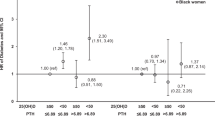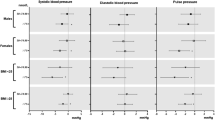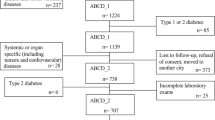Abstract
The objective was to examine whether there were causal links between vitamin D status, parathyroid hormone, insulin resistance (IR)/insulin sensitivity (IS) and the metabolic syndrome (MS). A total of 72 Caucasian men and women, aged 55.7±7.57 years, with body mass index 33.4±4.02 kg/m2 and abdominal obesity, were assessed for IR/IS based on three commonly used indices before and after 12 weeks of supervised weight loss. During weight stability, though both lower intact parathyroid hormone (iPTH) and higher vitamin D were independently associated with greater IS/lower IR, this was consistent for iPTH across the surrogate measures tested. Higher iPTH, but not lower vitamin D, increased the risk of MS after adjustment for IR/IS. Weight loss resulted in significant reductions in percent fat (−2.83±2.20%), waist (−9.26±5.11 cm), improvements in all IS indices, reductions in MS and iPTH (−0.28±1.17 pmol/l), but no increase in vitamin D (+2.19±12.17 nmol/l). Following weight loss, ΔiPTH either predicted change in IR/IS or contributed to their variance by 4.1–8.9%. On adjustment for IR/IS, higher ΔiPTH did not significantly predict MS after weight loss, though the odds ratios for the effect were sizeable. The data are suggestive of an intrinsic inverse relationship between iPTH and IS in abdominally obese individuals, independent of vitamin D. There remains the possibility of a direct relationship between iPTH and MS.
This is a preview of subscription content, access via your institution
Access options
Subscribe to this journal
Receive 12 print issues and online access
$259.00 per year
only $21.58 per issue
Buy this article
- Purchase on Springer Link
- Instant access to full article PDF
Prices may be subject to local taxes which are calculated during checkout
Similar content being viewed by others
References
Alberti KGMM, Eckel RH, Grundy SM, Zimmet PZ, Cleeman JI, Donato KA et al. (2009). Harmonizing the metabolic syndrome. A joint interim statement of the International Diabetes Federation Task Force on Epidemiology and Prevention; National Heart, Lung, and Blood Institute; American Heart Association; World Heart Federation; International Atherosclerosis Society; and International Association for the Study of Obesity. Circulation 120, 1640–1645.
Buchanan TA, Watanabe RM, Xiang AH (2010). Limitations in surrogate measures of insulin resistance. J Clin Endocrinol Metab 95, 4874–4876.
Del Gobbo LC, Song Y, Dannenbaum DA, Dewailly E, Egeland GM (2011). Serum 25-hydroxyvitamin D is not associated with insulin resistance or beta cell function in Canadian Cree. J Nutr 141 (Suppl 2), 290–295.
Chan She Ping-Delfos W (2009). Effects of Dairy Products and Resistance Exercise on Energy Balance PhD Thesis. Curtin University of Technology: Perth, Western Australia.
Cummings NK (2006). The Potential Role of Calcium in Obesity PhD Thesis. Curtin University of Technology: Perth, Western Australia.
Field A (2007). Discovering Statistics using SPSS. SAGE Publications: Los Angeles, USA, pp 173.
Ford ES, Zhao G, Li C, Pearson WS (2009). Serum concentrations of vitamin D and parathyroid hormone and prevalent metabolic syndrome among adults in the United States. J Diabetes 1, 296–303.
Hjelmesaeth J, Hofso D, Aasheim ET, Jenssen T, Moan J, Hager H et al. (2009). Parathyroid hormone, but not vitamin D, is associated with the metabolic syndrome in morbidly obese women and men: a cross-sectional study. Cardiovasc Diabetol 8, 1–7.
Kim MK, Kang M, Oh KW, Kwon HS, Lee JH, Lee WC et al. (2010). The association of serum vitamin D level with presence of metabolic syndrome and hypertension in middle-aged Korean subjects. Clinic endocrinol 73, 330–338.
Lee DM, Rutter MK, O’Neill TW, Boonen S, Vanderschueren D, Bouillon R et al. (2009). Vitamin D, parathyroid hormone and the metabolic syndrome in middle-aged and older European men. Eur J Endocrinol 161, 947–954.
Lerman I, Villa AR, Torres JMR, Tamez LE, Perez FG, del Villar Velasco SC et al. (2003). Correlations between surrogate measures of insulin resistance and cardiovascular risk factors in obese and overweight patients. J Diabetes Complications 17, 66–72.
Lorenzo C, Haffner SM, Stancáková A, Laakso M (2010). Relation of direct and surrogate measures of insulin resistance to cardiovascular risk factors in nondiabetic Finnish offspring of Type 2 diabetic individuals. J Clin Endocrinol Metab 95, 5082–5090.
Matthews DR, Hosker JP, Rudenski AS, Naylor BA, Teacher DF, Turner RC (1985). Homeostasis model assessment: insulin resistance and β cell function from fasting plasma glucose and insulin concentrations in man. Diabetologia 28, 412–419.
McAuley KA, Williams SM, Mann JI, Walker RJ, Ledwis-Barned NJ, Temple LA et al. (2001). Diagnosing insulin resistance in the general population. Diabetes Care 24, 460–464.
Nagpal J, Pande JN, Bhartia A (2008). A double-blind, randomized, placebo-controlled trial of the short-term effect of vitamin D3 supplementation on insulin sensitivity in apparently healthy, middle-aged, centrally obese men. Diabet Med 26, 19–27.
Nowson CA, Margerison C (2002). Vitamin D intake and vitamin D status of Australians. eMJA 177, 149–152.
O’Dea K, Rowley KG (2002). Macrovascular disease risk factors and insulin resistance in Aboriginal and Torres Strait Islander people. J Diabetes Complications 16, 9–16.
Pittas AG, Lau J, Hu FB, Dawson-Hughes B (2007). The role of vitamin D and calcium in type 2 diabetes: a systematic review and meta-analysis. Clin Endocrinol Metab 92, 2017–2029.
Peterlik M, Cross H (2009). Vitamin D and calcium insufficiency-related chronic diseases: molecular and cellular pathophysiology. Eur J Nutr 105, 1–10.
Reis JP, Mühlen DV, Kritz-Silverstein D, Wingard DL, Barret-Connor E (2007). Vitamin D, parathyroid hormone levels, and the prevalence of metabolic syndrome in community-dwelling older adults. Diabetes Care 30 (Suppl 6), 1549–1555.
Rueda S, Fernández-fernández C, Romero F, de Osaba MJM, Vidal J (2008). Vitamin D, PTH, and the metabolic syndrome in severely obese subjects. Obes Surg 18 (Suppl 2), 151–154.
Soares MJ, Chan She-Ping-Delfos WL (2010). Postprandial energy metabolism in the regulation of body weight: is there a mechanistic role for dietary calcium. Nutrients 2, 586–598.
Soares MJ, Kuriyan R, Kurpad AV (2010). Calcium and vitamin D modulate postprandial vascular function: a pilot dose–response study. Diab Met Syndr: Clin Res Rev 4, 128–131.
Tai K, Need AG, Horowitz M, Chapman IM (2008). Glucose tolerance and vitamin D: effects of treating vitamin D deficiency. Nutrition 24 (Suppl 10), 950–956.
Von-Hurst PR, Stonehouse W, Coad J (2010). Vitamin D supplementation reduces insulin resistance in South Asian women living in New Zealand who are insulin resistant and vitamin D deficient—a randomized, placebo-controlled trial. Br J Nutr 103, 549–555.
Wallace TM, Levy JC, Matthews DR (2004). Use and abuse of HOMA modeling. Diabetes Care 27, 1487–1495.
Acknowledgements
We thank Dr Leonard S Piers, Tony James, Deepa Sriram and Kyla Smith for their expert assistance with our research. MJS acknowledges financial support from Dairy Australia, the ATN Centre for Metabolic Fitness and Diabetes Australia. No prior permission was required from these organizations for submission of this manuscript.
Author information
Authors and Affiliations
Corresponding author
Ethics declarations
Competing interests
The authors declare no conflict of interest.
Rights and permissions
About this article
Cite this article
Soares, M., Ping-Delfos, W., Sherriff, J. et al. Vitamin D and parathyroid hormone in insulin resistance of abdominal obesity: cause or effect?. Eur J Clin Nutr 65, 1348–1352 (2011). https://doi.org/10.1038/ejcn.2011.111
Received:
Revised:
Accepted:
Published:
Issue Date:
DOI: https://doi.org/10.1038/ejcn.2011.111
Keywords
This article is cited by
-
Association of vitamin D deficiency and insulin resistance in nondiabetic obese women: role of parathyroid hormone
International Journal of Diabetes in Developing Countries (2023)
-
Determinants of High Parathyroid Hormone Levels in Patients With Severe Obesity and Their Relationship With the Cardiometabolic Risk Factors, Before and After a Laparoscopic Sleeve Gastrectomy Intervention
Obesity Surgery (2020)
-
Factors determining the risk of the metabolic syndrome: is there a central role for adiponectin?
European Journal of Clinical Nutrition (2013)
-
Plasma vitamin D and parathormone are associated with obesity and atherogenic dyslipidemia: a cross-sectional study
Cardiovascular Diabetology (2012)
-
Predicted 25-hydroxyvitamin D score and change in fasting plasma glucose in the Framingham offspring study
European Journal of Clinical Nutrition (2012)



